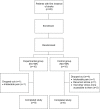Selection of acupoints for managing upper-extremity spasticity in chronic stroke patients
- PMID: 24453485
- PMCID: PMC3894143
- DOI: 10.2147/CIA.S53814
Selection of acupoints for managing upper-extremity spasticity in chronic stroke patients
Abstract
Background: This study investigated the clinical efficacy of electroacupuncture (EA) in inhibiting upper-extremity spasticity in chronic stroke patients, and also in mapping a unique preliminary acupoint-selection protocol.
Methods: Fifteen patients were divided into two groups: patients in the control group (n=6) received minimal acupuncture (MA), and those in the experimental group (n=9) received EA. Four acupoints, which include Neiguan (PC6), Shaohai (HT3), Zeqian (Ex-UE, A32), and Shounizhu (EX-UE), were treated near the motor points of the muscles for elbow flexion, forearm pronation, and finger flexion. Both groups were treated for twelve sessions, 20 minutes per session, for 6 weeks (two sessions per week). The outcome measures in this study included angle of muscle reaction (R1), passive range of motion (R2), and dynamic component (R2-R1).
Results: In the experimental group, the R2-R1 of the elbow joint was significantly decreased at 1 (P=0.0079), 3 (P=0.0013), and 6 weeks (P=0.0149) after treatment compared with pretreatment levels (P<0.05). The between-group difference in the R2-R1 of the elbow joint after the 6-week treatment was statistically significant.
Conclusion: Combining the 6-week EA and standard rehabilitation treatment reduced the spasticity of the elbow for chronic stroke survivors. However, no significant effect was observed in the spasticity of the wrist joints. The choice of acupoints and the frequency of EA have to be taken into account to achieve a positive treatment effect. The correlation between acupoints and motor points provides a model of acupoint selection to improve spasticity.
Keywords: acupoints; acupuncture; electroacupuncture; motor point; spasticity; stroke.
Figures



References
-
- Department of Health . 2010 Statistics of Causes of Death. Taipei: Department of Health; 2011. pp. 92–98.
-
- Lin JH, Chang CM, Huang MH, et al. A follow-up study of first stroke patients after inpatient rehabilitation. Formos J Phys Ther. 2001;26(4):196–204.
-
- Sommerfeld DK, Eek EU, Svensson AK, Holmqvist LW, von Arbin MH. Spasticity after stroke: its occurrence and association with motor impairments and activity limitations. Stroke. 2004;35(1):134–139. - PubMed
-
- Braddom RL. Physical Medicine and Rehabilitation. 4th ed. Philadelphia: Elsevier; 2010.
Publication types
MeSH terms
LinkOut - more resources
Full Text Sources
Other Literature Sources
Medical

